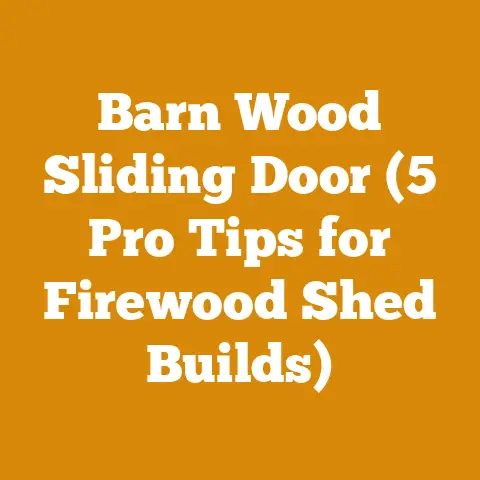Woodburner with Back Boiler (7 Expert Tips for Efficient Heating)
Aha! I remember the bone-chilling winter of ’08. My old farmhouse felt colder inside than out, despite the roaring fire in my open hearth. It was costing me a fortune in propane, and frankly, I was tired of the uneven heat. That’s when I started looking into wood burners with back boilers – a decision that not only warmed my home more efficiently but also dramatically slashed my heating bills. If you’re grappling with similar issues, you’re in the right place. Let’s dive into how you can harness the power of a wood burner with a back boiler to create a cozy, cost-effective haven.
Woodburner with Back Boiler: 7 Expert Tips for Efficient Heating
Wood burners with back boilers are a fantastic way to leverage the natural heat of a wood fire to warm your entire home and even provide hot water. However, maximizing their efficiency requires understanding a few key principles. Over the years, I’ve learned these lessons through trial and error, tweaking my setup, and constantly seeking ways to improve performance. Let’s get started.
1. Understanding the Basics: How Wood Burners with Back Boilers Work
At its core, a wood burner with a back boiler is a standard wood-burning stove with an integrated water-heating system. The “back boiler” is essentially a water tank or series of pipes located behind or around the firebox. As the fire burns, it heats the water within the boiler. This hot water can then be circulated through your home’s central heating system, radiators, and even used for domestic hot water needs.
Key Components:
- Firebox: The chamber where the wood burns.
- Back Boiler: The water-filled tank or pipes that absorb heat from the fire.
- Circulation Pump: Moves the heated water through the system.
- Expansion Tank: Accommodates the expansion of water as it heats.
- Radiators/Underfloor Heating: Distribute the heat throughout your home.
- Thermostatic Mixing Valve (TMV): Regulates the temperature of the hot water to prevent scalding.
- Safety Relief Valve: Releases excess pressure in the system to prevent explosions.
- Thermal Store (Optional): A large insulated tank that stores hot water for later use, improving efficiency and providing a buffer against fluctuating fire temperatures.
How it Works – A Step-by-Step Guide:
- Fire is Lit: You light a fire in the firebox of the wood burner.
- Heat Transfer: The heat from the fire radiates outwards, warming the firebox and, crucially, the back boiler.
- Water Heating: The water within the back boiler absorbs this heat, increasing in temperature.
- Circulation: A circulation pump, typically thermostatically controlled, kicks in when the water reaches a certain temperature (e.g., 140°F/60°C).
- Heat Distribution: The pump circulates the hot water through the heating system – radiators, underfloor heating, or a combination of both.
- Heat Exchange: As the hot water flows through the radiators, it releases heat into the room, warming the space. The water then returns to the back boiler to be reheated.
- Domestic Hot Water (Optional): Some systems also incorporate a heat exchanger to heat domestic hot water. This involves passing the hot water from the back boiler through a coil within a separate tank containing potable water.
- Thermostatic Control: Thermostats throughout the house monitor the temperature and adjust the circulation pump and radiator valves to maintain a consistent and comfortable temperature.
- Safety Mechanisms: The expansion tank accommodates the increase in water volume as it heats, preventing pressure build-up. The safety relief valve provides an additional layer of protection, releasing excess pressure if necessary.
Why Choose a Wood Burner with Back Boiler?
- Cost Savings: Significantly reduces reliance on fossil fuels like oil, propane, or natural gas, leading to lower heating bills.
- Environmental Friendliness: Wood is a renewable resource, and burning it can be carbon-neutral if sourced sustainably.
- Off-Grid Potential: Provides a degree of energy independence, especially valuable during power outages.
- Whole-House Heating: Offers a more even and consistent heat distribution compared to traditional wood stoves.
- Domestic Hot Water: Can provide hot water for showers, washing dishes, and other household needs.
Data Point: According to the Energy Information Administration (EIA), the average US household spends over \$1,200 annually on heating. Switching to a wood burner with a back boiler can potentially reduce these costs by 30-70%, depending on wood availability and usage patterns.
2. Selecting the Right Wood Burner and Boiler Size
Choosing the right wood burner with a back boiler is crucial for efficient heating. It’s not just about picking the prettiest stove; it’s about matching the unit’s output to your home’s heating needs. I’ve seen folks make the mistake of getting a boiler that’s too small, leaving them shivering, or one that’s too large, leading to overheating and wasted fuel.
Sizing Considerations:
- House Size: The square footage of your home is a primary factor. A larger home requires a more powerful boiler.
- Insulation: Well-insulated homes require less heat to maintain a comfortable temperature.
- Climate: Colder climates demand a higher BTU (British Thermal Unit) output.
- Existing Heating System: Consider how the wood burner will integrate with your existing system. Will it be a primary or supplementary heat source?
- Hot Water Needs: Factor in the number of occupants and their hot water consumption habits.
BTU Calculation:
A rough estimate is to calculate 30-50 BTU per square foot of living space in colder climates. For example, a 2,000 square foot home might require a boiler with a 60,000-100,000 BTU output. However, this is just a starting point. Consult with a qualified heating professional for a more accurate assessment.
Boiler Capacity:
Boiler capacity is typically measured in kilowatts (kW) or BTU per hour. A 1 kW boiler produces approximately 3,412 BTU per hour. For domestic hot water, a boiler with a capacity of 1 kW per person is generally sufficient.
Wood Burner Types:
- Steel Wood Burners: Durable, affordable, and heat up quickly.
- Cast Iron Wood Burners: Retain heat longer, providing a more consistent heat output.
- Hybrid Wood Burners: Combine steel and cast iron for a balance of durability and heat retention.
Back Boiler Design:
- Wrap-Around Boilers: Surround the firebox, maximizing heat transfer.
- Insert Boilers: Fit inside the firebox, offering a more compact design.
Important Considerations:
- Efficiency Rating: Look for models with high efficiency ratings (70% or higher) to maximize heat output and minimize fuel consumption.
- Emissions: Choose a wood burner that meets EPA (Environmental Protection Agency) emission standards to reduce air pollution.
- Safety Features: Ensure the unit has safety features like a pressure relief valve and a high-temperature limit switch.
- Warranty: A good warranty provides peace of mind and protects your investment.
Example:
I once helped a friend choose a wood burner with a back boiler for his 1,500 square foot home in Maine. After assessing his insulation and hot water needs, we opted for a 75,000 BTU steel wood burner with a wrap-around boiler. This setup provided ample heat for his home and hot water for his family of four, significantly reducing his oil consumption.
Data Point: A study by the Biomass Energy Resource Center (BERC) found that properly sized and installed wood burners with back boilers can reduce heating costs by 40-60% compared to traditional fossil fuel systems.
3. Installation Best Practices: Safety First
Installing a wood burner with a back boiler is not a DIY project for the faint of heart. It involves plumbing, electrical work, and a thorough understanding of building codes and safety regulations. I always recommend hiring a qualified and certified installer to ensure the job is done correctly and safely. A mistake here can be costly, and even dangerous.
Key Installation Steps:
- Planning and Permits: Obtain the necessary permits from your local building department.
- Chimney Inspection: Ensure your chimney is in good condition and meets the requirements for wood-burning appliances. Consider a chimney liner if necessary.
- Clearance Requirements: Maintain proper clearances between the wood burner and combustible materials (walls, furniture, etc.). Consult the manufacturer’s instructions for specific requirements.
- Floor Protection: Install a non-combustible hearth pad under the wood burner to protect the floor from sparks and embers.
- Plumbing Connections: Connect the back boiler to your existing heating system, ensuring proper pipe sizing and insulation.
- Electrical Connections: Wire the circulation pump and other electrical components according to local codes.
- Expansion Tank Installation: Install an expansion tank to accommodate the increase in water volume as it heats.
- Safety Relief Valve Installation: Install a safety relief valve to release excess pressure in the system.
- Thermostatic Mixing Valve (TMV) Installation: Install a TMV to regulate the temperature of the hot water to prevent scalding.
- Testing and Commissioning: Thoroughly test the system to ensure it is functioning correctly and safely.
Safety Considerations:
- Carbon Monoxide Detectors: Install carbon monoxide detectors in your home to alert you to the presence of this odorless and deadly gas.
- Smoke Detectors: Ensure you have working smoke detectors on every level of your home.
- Fire Extinguisher: Keep a fire extinguisher readily accessible near the wood burner.
- Regular Inspections: Have your chimney and wood burner inspected annually by a qualified professional.
Common Mistakes to Avoid:
- Improper Chimney Installation: A poorly installed chimney can lead to smoke backdrafts and carbon monoxide poisoning.
- Insufficient Clearance: Failing to maintain proper clearances can cause a fire.
- Incorrect Pipe Sizing: Using the wrong size pipes can restrict water flow and reduce efficiency.
- Lack of Insulation: Insulating pipes and the back boiler helps to minimize heat loss.
- Ignoring Building Codes: Violating building codes can result in fines and safety hazards.
Real-World Example:
I once inspected a wood burner installation where the homeowner had attempted to do the plumbing himself. He had used the wrong type of pipe, failed to install an expansion tank, and neglected to properly insulate the pipes. The system was leaking, inefficient, and potentially dangerous. I strongly advised him to hire a qualified plumber to correct the mistakes before using the wood burner.
Data Point: According to the National Fire Protection Association (NFPA), heating equipment is a leading cause of home fires in the United States. Proper installation and maintenance are crucial to preventing these fires.
4. Fueling Your Fire: Wood Selection and Preparation
The type of wood you burn and how you prepare it dramatically impacts the efficiency and cleanliness of your wood burner. I’ve learned that burning green or unseasoned wood is like trying to run a marathon in flip-flops – you’ll get there eventually, but it’ll be a lot harder and less efficient.
Hardwood vs. Softwood:
- Hardwoods: Dense woods like oak, maple, ash, and beech burn hotter and longer, producing more heat per unit volume.
- Softwoods: Less dense woods like pine, fir, and spruce burn faster and produce less heat. They are better suited for starting fires or providing quick bursts of heat.
Moisture Content:
The moisture content of wood is the single most important factor affecting its burning efficiency. Green or unseasoned wood can contain up to 50% moisture, which must be evaporated before the wood can burn. This process consumes energy and reduces the overall heat output.
Ideal Moisture Content:
The ideal moisture content for burning wood is 20% or less. At this level, the wood burns cleanly and efficiently, producing maximum heat.
Seasoning Wood:
Seasoning wood involves drying it to reduce its moisture content. This process typically takes 6-12 months, depending on the type of wood, climate, and storage conditions.
Seasoning Tips:
- Split the Wood: Splitting wood increases its surface area, allowing it to dry faster.
- Stack it Properly: Stack the wood in a single row, allowing air to circulate freely.
- Elevate the Stack: Elevate the stack off the ground to prevent moisture from wicking up from the soil.
- Cover the Top: Cover the top of the stack to protect it from rain and snow.
- Choose a Sunny Location: Place the stack in a sunny location to maximize drying.
Measuring Moisture Content:
You can measure the moisture content of wood using a moisture meter. Simply insert the probes into a freshly split piece of wood and read the percentage.
Wood Storage:
Store seasoned wood in a dry, sheltered location to prevent it from reabsorbing moisture.
Data Point: According to the EPA, burning seasoned wood can reduce emissions by up to 50% compared to burning green wood.
Personal Story:
I once made the mistake of burning a load of “seasoned” wood that turned out to be anything but. It was heavy, damp, and produced a thick, acrid smoke. My wood burner struggled to maintain a decent temperature, and my chimney quickly became coated with creosote. I learned my lesson the hard way – always check the moisture content of your wood before burning it!
5. Optimizing Combustion: Airflow and Fire Management
Mastering the art of fire management is essential for maximizing the efficiency of your wood burner. It’s not just about throwing logs into the firebox and hoping for the best. It’s about understanding how airflow, fuel load, and firebox temperature interact to create a clean and efficient burn.
Airflow Control:
Wood burners have primary and secondary air controls that regulate the amount of air entering the firebox.
- Primary Air: Provides air for combustion at the base of the fire.
- Secondary Air: Introduces air higher in the firebox to burn off smoke and gases.
Optimizing Airflow:
- Starting a Fire: Open both primary and secondary air controls to provide ample air for ignition.
- Maintaining a Fire: Gradually reduce the primary air and adjust the secondary air to achieve a clean, steady burn.
- Avoid Over-Damping: Closing the air controls too much can starve the fire of oxygen, leading to incomplete combustion and increased emissions.
Fuel Load:
The amount of wood you load into the firebox also affects combustion efficiency.
- Overloading: Overloading the firebox can smother the fire and lead to incomplete combustion.
- Underloading: Underloading the firebox can result in a weak fire that produces less heat.
Firebox Temperature:
Maintaining a high firebox temperature is crucial for efficient combustion.
- Temperature Gauge: Use a stove thermometer to monitor the firebox temperature.
- Ideal Temperature: The ideal firebox temperature is typically between 400°F and 700°F (200°C and 370°C).
- Avoid Overheating: Overheating the firebox can damage the wood burner and create a fire hazard.
Burning Techniques:
- Top-Down Burning: Light the fire from the top down, allowing the wood to burn slowly and cleanly.
- Front-to-Back Burning: Load the wood from front to back, allowing the fire to gradually consume the fuel.
- Cross-Stacking: Stack the wood in a crisscross pattern to promote airflow.
Data Point: A study by the Hearth, Patio & Barbecue Association (HPBA) found that proper fire management can increase the efficiency of a wood burner by up to 20%.
Experience:
I remember experimenting with different burning techniques and airflow settings to find the sweet spot for my wood burner. It took some time and patience, but eventually, I learned how to create a fire that burned hot, clean, and efficiently. It’s a skill that has saved me a lot of wood and kept my home warm and cozy.
6. Maintaining Your System: Cleaning and Inspections
Regular maintenance is essential for keeping your wood burner with a back boiler running efficiently and safely. Neglecting maintenance can lead to reduced performance, increased emissions, and even dangerous situations.
Chimney Cleaning:
Creosote buildup in the chimney is a serious fire hazard. Creosote is a tar-like substance that forms when wood smoke condenses in the chimney. It is highly flammable and can ignite, causing a chimney fire.
- Frequency: Clean your chimney at least once a year, or more often if you burn a lot of wood or burn green wood.
- Professional Cleaning: Hire a qualified chimney sweep to clean your chimney.
- DIY Cleaning: If you choose to clean your chimney yourself, be sure to use the proper tools and techniques.
Wood Burner Cleaning:
- Ash Removal: Remove ash from the firebox regularly to maintain airflow and prevent corrosion.
- Glass Cleaning: Clean the glass door with a specialized glass cleaner to remove soot and creosote.
- Gasket Inspection: Inspect the door gasket and replace it if it is damaged or worn.
- Baffle Inspection: Inspect the baffle and clean it if it is coated with creosote.
Back Boiler Maintenance:
- Water Level: Check the water level in the back boiler regularly and add water as needed.
- Pressure Relief Valve: Test the pressure relief valve periodically to ensure it is functioning properly.
- Circulation Pump: Inspect the circulation pump and lubricate it as needed.
- Expansion Tank: Check the expansion tank and adjust the pressure if necessary.
- Annual Inspection: Have your entire system inspected annually by a qualified technician.
Data Point: According to the Chimney Safety Institute of America (CSIA), chimney fires are a leading cause of home heating fires in the United States. Regular cleaning and inspections can significantly reduce the risk of a chimney fire.
Personal Story:
I once neglected to clean my chimney for two years, thinking it wouldn’t make that much of a difference. Big mistake! One cold winter night, I heard a loud roaring sound coming from the chimney. I quickly realized it was a chimney fire. Fortunately, I was able to extinguish the fire before it spread to the rest of the house. That experience taught me the importance of regular chimney cleaning.
7. Integrating with Existing Systems: Hybrid Heating
One of the great advantages of a wood burner with a back boiler is its ability to integrate with existing heating systems, creating a hybrid heating solution. This allows you to leverage the benefits of both wood heat and your existing system, providing flexibility, efficiency, and backup.
Integration Options:
- Parallel System: The wood burner and the existing system operate independently, each heating the house as needed.
- Series System: The wood burner heats the water first, and then the existing system provides supplemental heat if needed.
- Thermal Store Integration: The wood burner heats a thermal store, which then supplies heat to the house and domestic hot water.
Benefits of Hybrid Heating:
- Flexibility: You can switch between wood heat and your existing system depending on your needs and preferences.
- Efficiency: You can optimize the use of both systems to minimize fuel consumption and heating costs.
- Backup: Your existing system provides a backup in case the wood burner is not functioning.
- Comfort: You can maintain a consistent and comfortable temperature throughout your home.
Control Systems:
Sophisticated control systems can automate the integration of the wood burner and the existing system. These systems can monitor temperature, water levels, and other parameters to optimize performance and efficiency.
Data Point: A study by the Oak Ridge National Laboratory (ORNL) found that hybrid heating systems can reduce heating costs by up to 30% compared to traditional heating systems.
Real-World Example:
I helped a friend integrate his wood burner with his existing propane furnace. We installed a parallel system with a smart thermostat that automatically switched between the two systems based on temperature and propane prices. This setup allowed him to enjoy the warmth and cost savings of wood heat while still having the convenience and reliability of his propane furnace as a backup.
Final Thoughts:
Embracing a wood burner with a back boiler is a journey, not a destination. It requires learning, adapting, and constantly seeking ways to improve efficiency and safety. But the rewards – a warm, comfortable home, lower heating bills, and a reduced environmental impact – are well worth the effort. I encourage you to take the plunge and experience the magic of wood heat for yourself. Just remember to do your research, follow best practices, and always prioritize safety.
Now, go forth and conquer those winter chills!






